HRES 2302 Assignment: Canadian Union of Postal Workers Report
VerifiedAdded on 2022/08/16
|7
|1622
|13
Report
AI Summary
This report provides a comprehensive analysis of the Canadian Union of Postal Workers (CUPW), a trade union representing postal workers in Canada. The report begins with an introduction to the CUPW, detailing its history, founding, and the sectors it represents. It explores significant events in the union's history, including key strikes and their impact on collective bargaining rights and wage increases. The report also addresses the current issues faced by the CUPW, such as contract negotiations, legislative challenges, and the impact of changes in the postal system. The report includes a personal observation on the benefits of joining the union, emphasizing job security and the protection of worker rights. The analysis draws on various sources, including on-line research, materials prepared by the union, and information from related organizations. The report concludes by summarizing the key findings and emphasizing the union's role in advocating for workers' rights and addressing social issues.
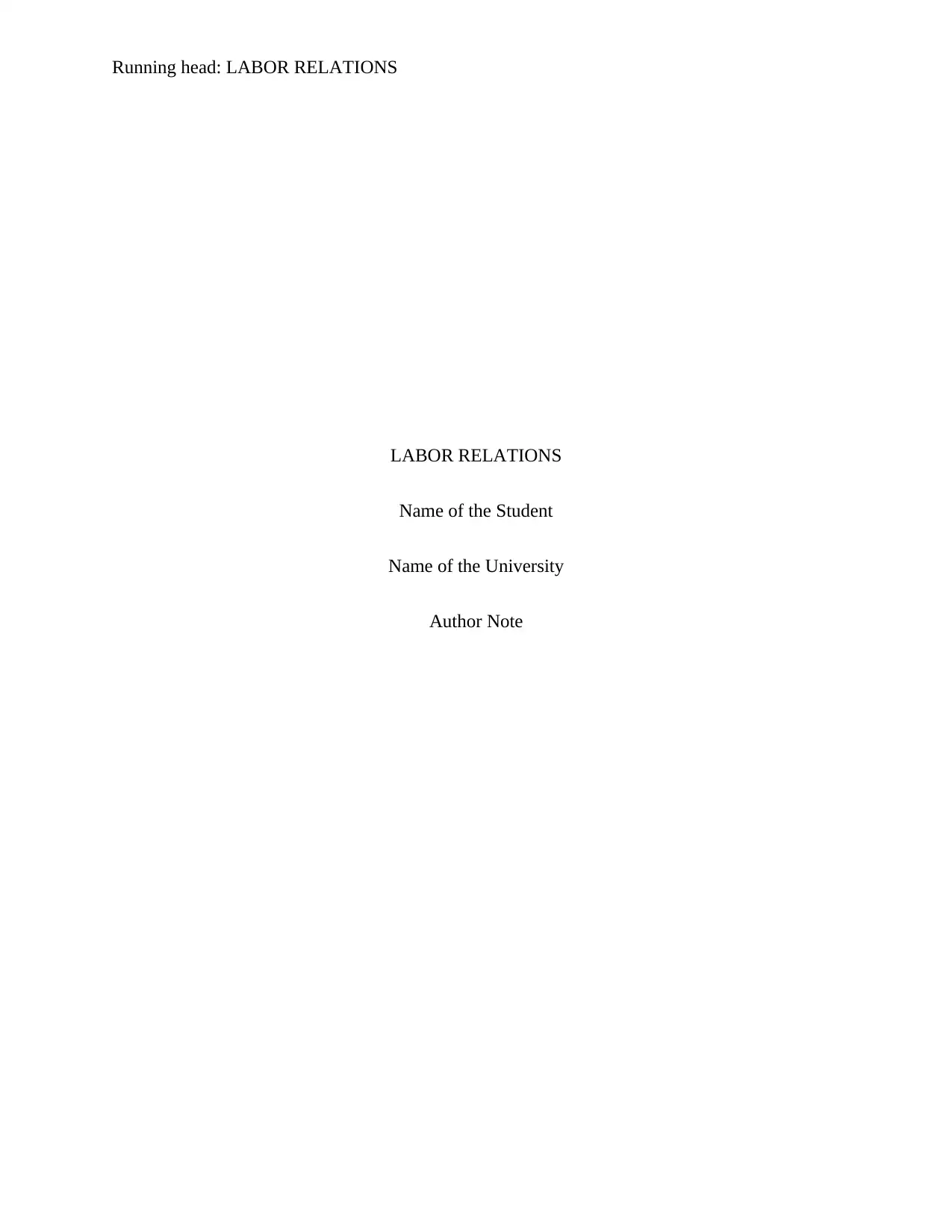
Running head: LABOR RELATIONS
LABOR RELATIONS
Name of the Student
Name of the University
Author Note
LABOR RELATIONS
Name of the Student
Name of the University
Author Note
Paraphrase This Document
Need a fresh take? Get an instant paraphrase of this document with our AI Paraphraser
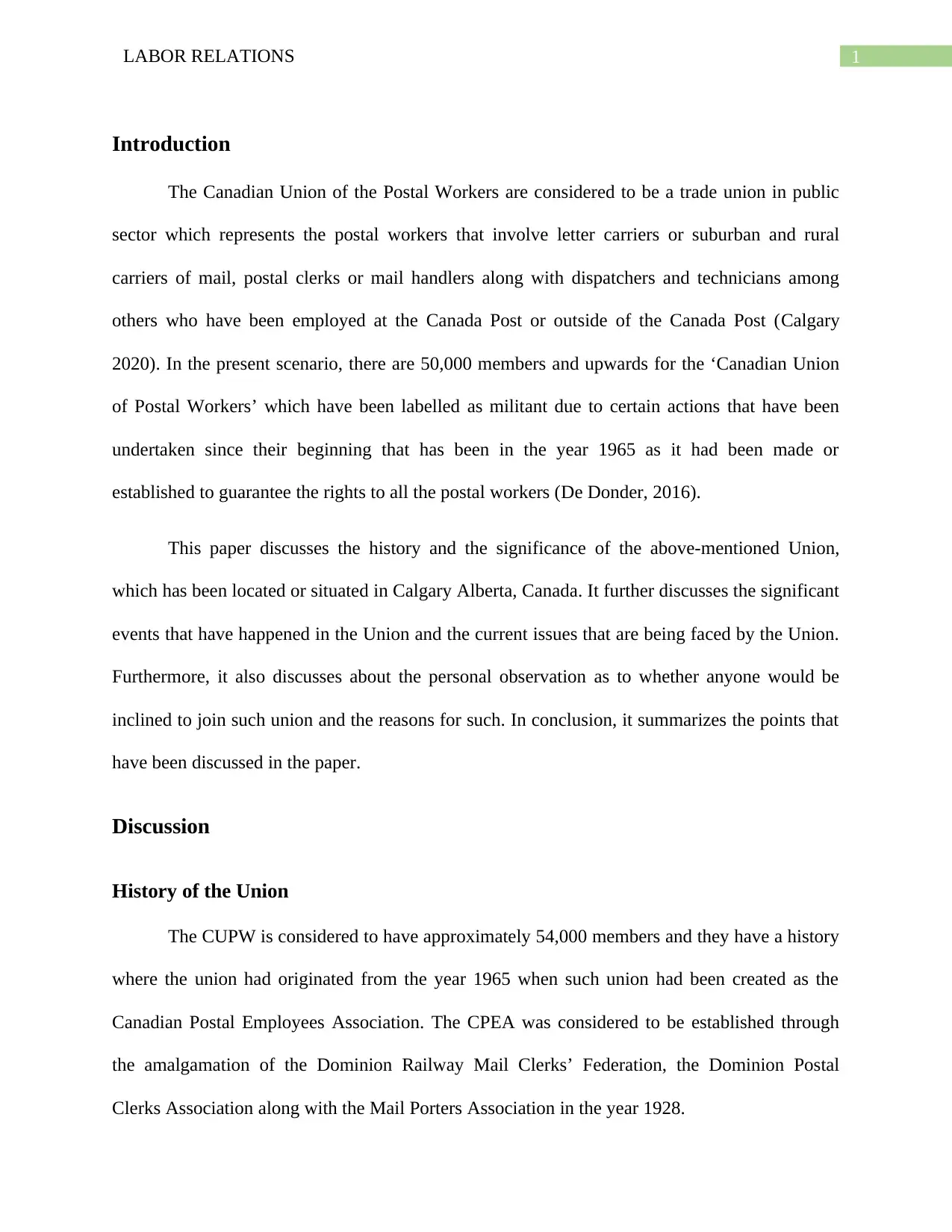
1LABOR RELATIONS
Introduction
The Canadian Union of the Postal Workers are considered to be a trade union in public
sector which represents the postal workers that involve letter carriers or suburban and rural
carriers of mail, postal clerks or mail handlers along with dispatchers and technicians among
others who have been employed at the Canada Post or outside of the Canada Post (Calgary
2020). In the present scenario, there are 50,000 members and upwards for the ‘Canadian Union
of Postal Workers’ which have been labelled as militant due to certain actions that have been
undertaken since their beginning that has been in the year 1965 as it had been made or
established to guarantee the rights to all the postal workers (De Donder, 2016).
This paper discusses the history and the significance of the above-mentioned Union,
which has been located or situated in Calgary Alberta, Canada. It further discusses the significant
events that have happened in the Union and the current issues that are being faced by the Union.
Furthermore, it also discusses about the personal observation as to whether anyone would be
inclined to join such union and the reasons for such. In conclusion, it summarizes the points that
have been discussed in the paper.
Discussion
History of the Union
The CUPW is considered to have approximately 54,000 members and they have a history
where the union had originated from the year 1965 when such union had been created as the
Canadian Postal Employees Association. The CPEA was considered to be established through
the amalgamation of the Dominion Railway Mail Clerks’ Federation, the Dominion Postal
Clerks Association along with the Mail Porters Association in the year 1928.
Introduction
The Canadian Union of the Postal Workers are considered to be a trade union in public
sector which represents the postal workers that involve letter carriers or suburban and rural
carriers of mail, postal clerks or mail handlers along with dispatchers and technicians among
others who have been employed at the Canada Post or outside of the Canada Post (Calgary
2020). In the present scenario, there are 50,000 members and upwards for the ‘Canadian Union
of Postal Workers’ which have been labelled as militant due to certain actions that have been
undertaken since their beginning that has been in the year 1965 as it had been made or
established to guarantee the rights to all the postal workers (De Donder, 2016).
This paper discusses the history and the significance of the above-mentioned Union,
which has been located or situated in Calgary Alberta, Canada. It further discusses the significant
events that have happened in the Union and the current issues that are being faced by the Union.
Furthermore, it also discusses about the personal observation as to whether anyone would be
inclined to join such union and the reasons for such. In conclusion, it summarizes the points that
have been discussed in the paper.
Discussion
History of the Union
The CUPW is considered to have approximately 54,000 members and they have a history
where the union had originated from the year 1965 when such union had been created as the
Canadian Postal Employees Association. The CPEA was considered to be established through
the amalgamation of the Dominion Railway Mail Clerks’ Federation, the Dominion Postal
Clerks Association along with the Mail Porters Association in the year 1928.
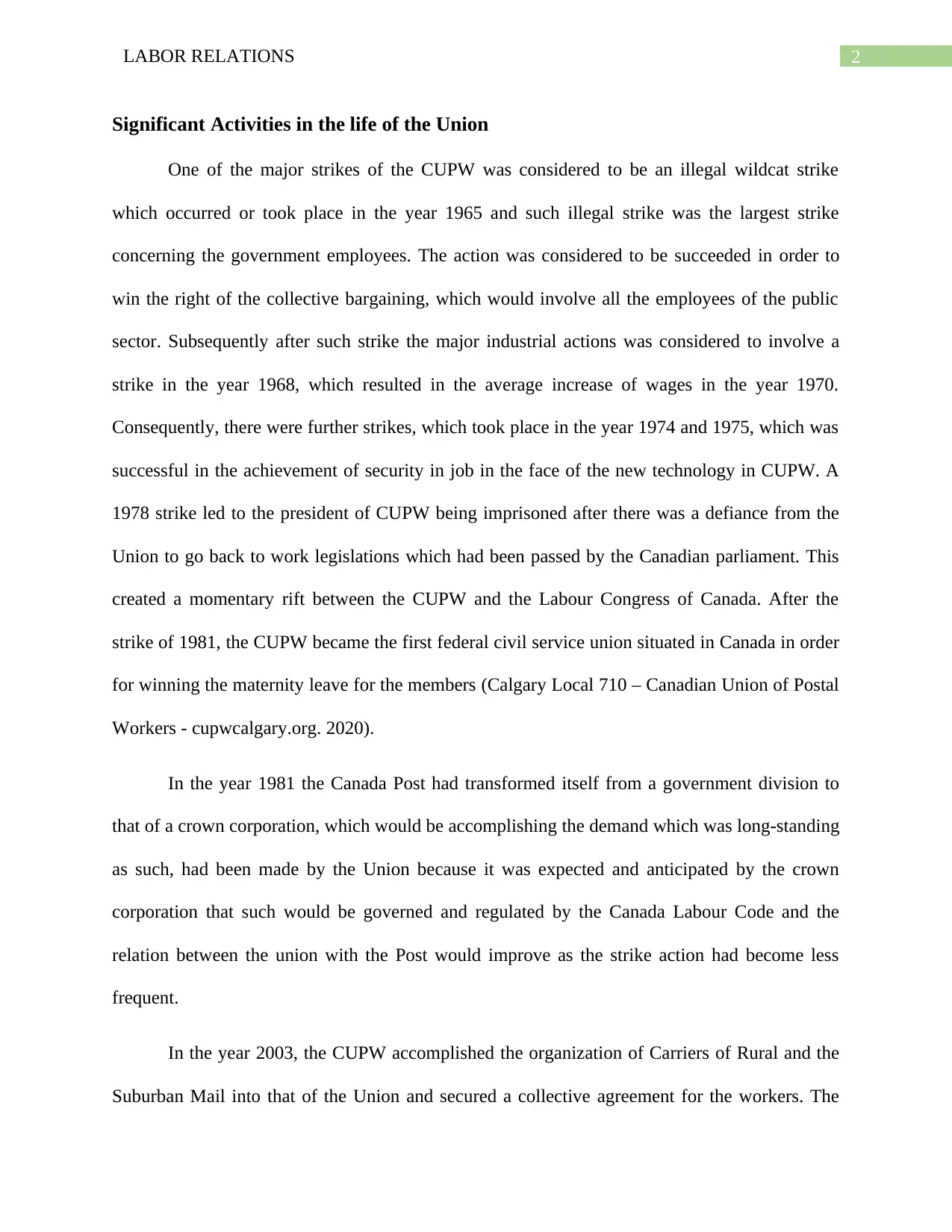
2LABOR RELATIONS
Significant Activities in the life of the Union
One of the major strikes of the CUPW was considered to be an illegal wildcat strike
which occurred or took place in the year 1965 and such illegal strike was the largest strike
concerning the government employees. The action was considered to be succeeded in order to
win the right of the collective bargaining, which would involve all the employees of the public
sector. Subsequently after such strike the major industrial actions was considered to involve a
strike in the year 1968, which resulted in the average increase of wages in the year 1970.
Consequently, there were further strikes, which took place in the year 1974 and 1975, which was
successful in the achievement of security in job in the face of the new technology in CUPW. A
1978 strike led to the president of CUPW being imprisoned after there was a defiance from the
Union to go back to work legislations which had been passed by the Canadian parliament. This
created a momentary rift between the CUPW and the Labour Congress of Canada. After the
strike of 1981, the CUPW became the first federal civil service union situated in Canada in order
for winning the maternity leave for the members (Calgary Local 710 – Canadian Union of Postal
Workers - cupwcalgary.org. 2020).
In the year 1981 the Canada Post had transformed itself from a government division to
that of a crown corporation, which would be accomplishing the demand which was long-standing
as such, had been made by the Union because it was expected and anticipated by the crown
corporation that such would be governed and regulated by the Canada Labour Code and the
relation between the union with the Post would improve as the strike action had become less
frequent.
In the year 2003, the CUPW accomplished the organization of Carriers of Rural and the
Suburban Mail into that of the Union and secured a collective agreement for the workers. The
Significant Activities in the life of the Union
One of the major strikes of the CUPW was considered to be an illegal wildcat strike
which occurred or took place in the year 1965 and such illegal strike was the largest strike
concerning the government employees. The action was considered to be succeeded in order to
win the right of the collective bargaining, which would involve all the employees of the public
sector. Subsequently after such strike the major industrial actions was considered to involve a
strike in the year 1968, which resulted in the average increase of wages in the year 1970.
Consequently, there were further strikes, which took place in the year 1974 and 1975, which was
successful in the achievement of security in job in the face of the new technology in CUPW. A
1978 strike led to the president of CUPW being imprisoned after there was a defiance from the
Union to go back to work legislations which had been passed by the Canadian parliament. This
created a momentary rift between the CUPW and the Labour Congress of Canada. After the
strike of 1981, the CUPW became the first federal civil service union situated in Canada in order
for winning the maternity leave for the members (Calgary Local 710 – Canadian Union of Postal
Workers - cupwcalgary.org. 2020).
In the year 1981 the Canada Post had transformed itself from a government division to
that of a crown corporation, which would be accomplishing the demand which was long-standing
as such, had been made by the Union because it was expected and anticipated by the crown
corporation that such would be governed and regulated by the Canada Labour Code and the
relation between the union with the Post would improve as the strike action had become less
frequent.
In the year 2003, the CUPW accomplished the organization of Carriers of Rural and the
Suburban Mail into that of the Union and secured a collective agreement for the workers. The
⊘ This is a preview!⊘
Do you want full access?
Subscribe today to unlock all pages.

Trusted by 1+ million students worldwide
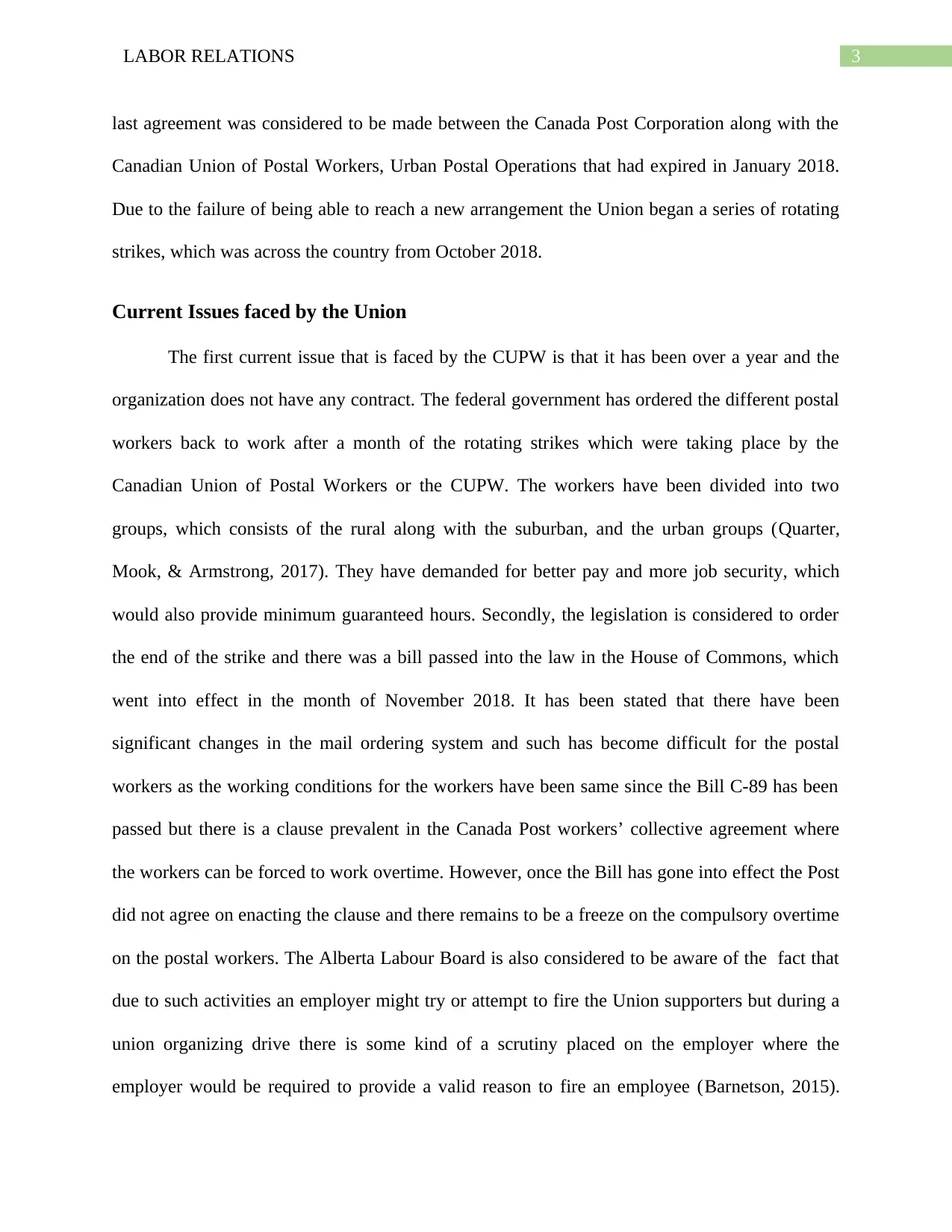
3LABOR RELATIONS
last agreement was considered to be made between the Canada Post Corporation along with the
Canadian Union of Postal Workers, Urban Postal Operations that had expired in January 2018.
Due to the failure of being able to reach a new arrangement the Union began a series of rotating
strikes, which was across the country from October 2018.
Current Issues faced by the Union
The first current issue that is faced by the CUPW is that it has been over a year and the
organization does not have any contract. The federal government has ordered the different postal
workers back to work after a month of the rotating strikes which were taking place by the
Canadian Union of Postal Workers or the CUPW. The workers have been divided into two
groups, which consists of the rural along with the suburban, and the urban groups (Quarter,
Mook, & Armstrong, 2017). They have demanded for better pay and more job security, which
would also provide minimum guaranteed hours. Secondly, the legislation is considered to order
the end of the strike and there was a bill passed into the law in the House of Commons, which
went into effect in the month of November 2018. It has been stated that there have been
significant changes in the mail ordering system and such has become difficult for the postal
workers as the working conditions for the workers have been same since the Bill C-89 has been
passed but there is a clause prevalent in the Canada Post workers’ collective agreement where
the workers can be forced to work overtime. However, once the Bill has gone into effect the Post
did not agree on enacting the clause and there remains to be a freeze on the compulsory overtime
on the postal workers. The Alberta Labour Board is also considered to be aware of the fact that
due to such activities an employer might try or attempt to fire the Union supporters but during a
union organizing drive there is some kind of a scrutiny placed on the employer where the
employer would be required to provide a valid reason to fire an employee (Barnetson, 2015).
last agreement was considered to be made between the Canada Post Corporation along with the
Canadian Union of Postal Workers, Urban Postal Operations that had expired in January 2018.
Due to the failure of being able to reach a new arrangement the Union began a series of rotating
strikes, which was across the country from October 2018.
Current Issues faced by the Union
The first current issue that is faced by the CUPW is that it has been over a year and the
organization does not have any contract. The federal government has ordered the different postal
workers back to work after a month of the rotating strikes which were taking place by the
Canadian Union of Postal Workers or the CUPW. The workers have been divided into two
groups, which consists of the rural along with the suburban, and the urban groups (Quarter,
Mook, & Armstrong, 2017). They have demanded for better pay and more job security, which
would also provide minimum guaranteed hours. Secondly, the legislation is considered to order
the end of the strike and there was a bill passed into the law in the House of Commons, which
went into effect in the month of November 2018. It has been stated that there have been
significant changes in the mail ordering system and such has become difficult for the postal
workers as the working conditions for the workers have been same since the Bill C-89 has been
passed but there is a clause prevalent in the Canada Post workers’ collective agreement where
the workers can be forced to work overtime. However, once the Bill has gone into effect the Post
did not agree on enacting the clause and there remains to be a freeze on the compulsory overtime
on the postal workers. The Alberta Labour Board is also considered to be aware of the fact that
due to such activities an employer might try or attempt to fire the Union supporters but during a
union organizing drive there is some kind of a scrutiny placed on the employer where the
employer would be required to provide a valid reason to fire an employee (Barnetson, 2015).
Paraphrase This Document
Need a fresh take? Get an instant paraphrase of this document with our AI Paraphraser
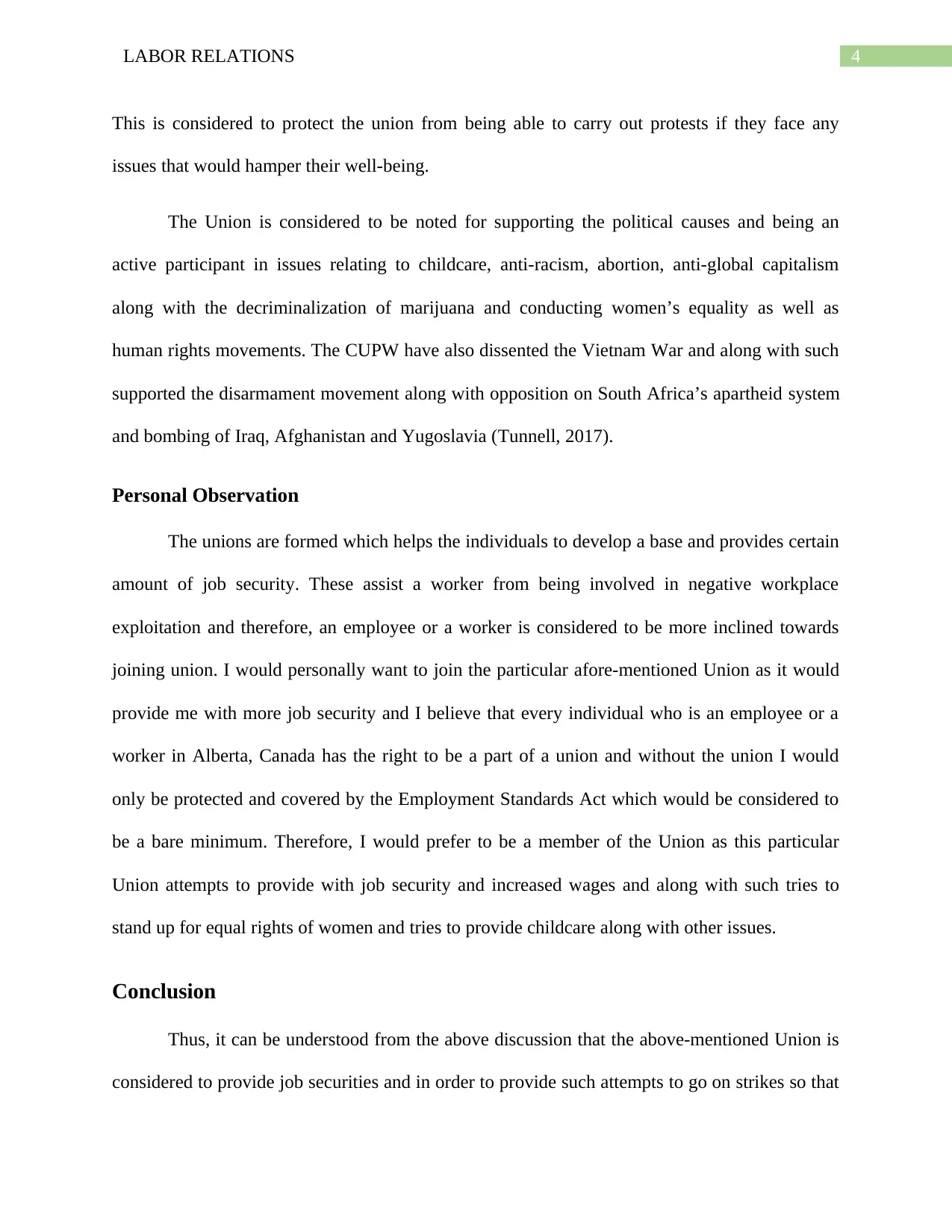
4LABOR RELATIONS
This is considered to protect the union from being able to carry out protests if they face any
issues that would hamper their well-being.
The Union is considered to be noted for supporting the political causes and being an
active participant in issues relating to childcare, anti-racism, abortion, anti-global capitalism
along with the decriminalization of marijuana and conducting women’s equality as well as
human rights movements. The CUPW have also dissented the Vietnam War and along with such
supported the disarmament movement along with opposition on South Africa’s apartheid system
and bombing of Iraq, Afghanistan and Yugoslavia (Tunnell, 2017).
Personal Observation
The unions are formed which helps the individuals to develop a base and provides certain
amount of job security. These assist a worker from being involved in negative workplace
exploitation and therefore, an employee or a worker is considered to be more inclined towards
joining union. I would personally want to join the particular afore-mentioned Union as it would
provide me with more job security and I believe that every individual who is an employee or a
worker in Alberta, Canada has the right to be a part of a union and without the union I would
only be protected and covered by the Employment Standards Act which would be considered to
be a bare minimum. Therefore, I would prefer to be a member of the Union as this particular
Union attempts to provide with job security and increased wages and along with such tries to
stand up for equal rights of women and tries to provide childcare along with other issues.
Conclusion
Thus, it can be understood from the above discussion that the above-mentioned Union is
considered to provide job securities and in order to provide such attempts to go on strikes so that
This is considered to protect the union from being able to carry out protests if they face any
issues that would hamper their well-being.
The Union is considered to be noted for supporting the political causes and being an
active participant in issues relating to childcare, anti-racism, abortion, anti-global capitalism
along with the decriminalization of marijuana and conducting women’s equality as well as
human rights movements. The CUPW have also dissented the Vietnam War and along with such
supported the disarmament movement along with opposition on South Africa’s apartheid system
and bombing of Iraq, Afghanistan and Yugoslavia (Tunnell, 2017).
Personal Observation
The unions are formed which helps the individuals to develop a base and provides certain
amount of job security. These assist a worker from being involved in negative workplace
exploitation and therefore, an employee or a worker is considered to be more inclined towards
joining union. I would personally want to join the particular afore-mentioned Union as it would
provide me with more job security and I believe that every individual who is an employee or a
worker in Alberta, Canada has the right to be a part of a union and without the union I would
only be protected and covered by the Employment Standards Act which would be considered to
be a bare minimum. Therefore, I would prefer to be a member of the Union as this particular
Union attempts to provide with job security and increased wages and along with such tries to
stand up for equal rights of women and tries to provide childcare along with other issues.
Conclusion
Thus, it can be understood from the above discussion that the above-mentioned Union is
considered to provide job securities and in order to provide such attempts to go on strikes so that
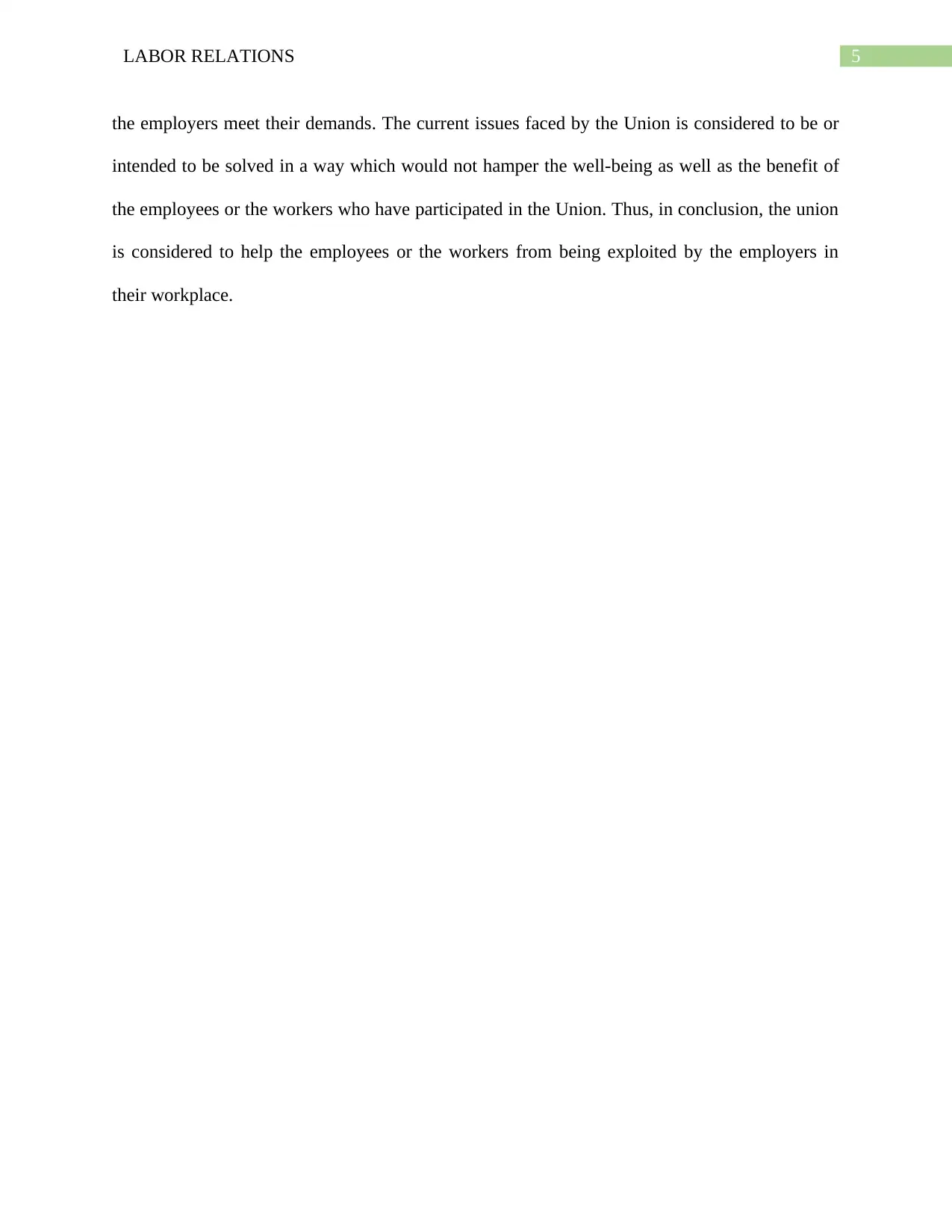
5LABOR RELATIONS
the employers meet their demands. The current issues faced by the Union is considered to be or
intended to be solved in a way which would not hamper the well-being as well as the benefit of
the employees or the workers who have participated in the Union. Thus, in conclusion, the union
is considered to help the employees or the workers from being exploited by the employers in
their workplace.
the employers meet their demands. The current issues faced by the Union is considered to be or
intended to be solved in a way which would not hamper the well-being as well as the benefit of
the employees or the workers who have participated in the Union. Thus, in conclusion, the union
is considered to help the employees or the workers from being exploited by the employers in
their workplace.
⊘ This is a preview!⊘
Do you want full access?
Subscribe today to unlock all pages.

Trusted by 1+ million students worldwide
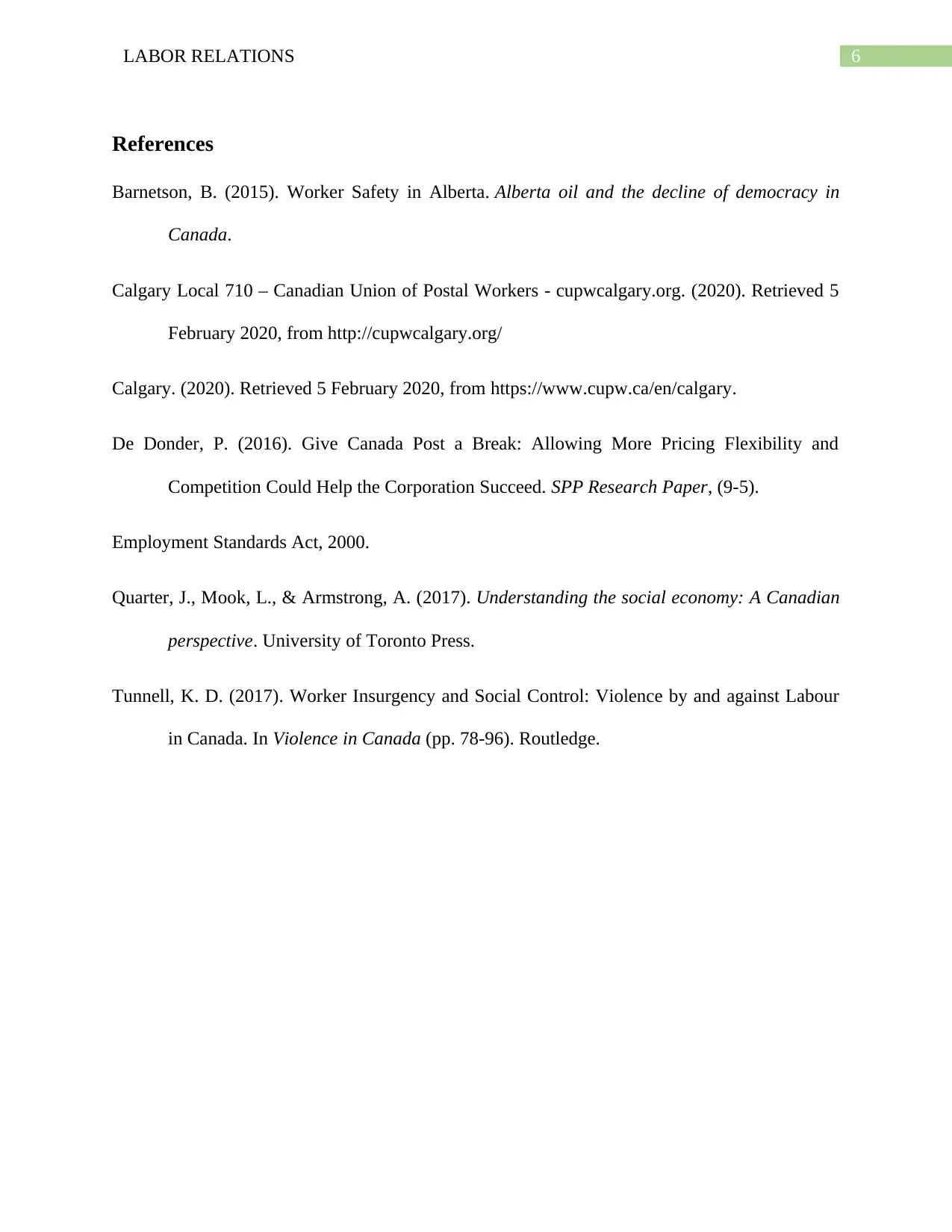
6LABOR RELATIONS
References
Barnetson, B. (2015). Worker Safety in Alberta. Alberta oil and the decline of democracy in
Canada.
Calgary Local 710 – Canadian Union of Postal Workers - cupwcalgary.org. (2020). Retrieved 5
February 2020, from http://cupwcalgary.org/
Calgary. (2020). Retrieved 5 February 2020, from https://www.cupw.ca/en/calgary.
De Donder, P. (2016). Give Canada Post a Break: Allowing More Pricing Flexibility and
Competition Could Help the Corporation Succeed. SPP Research Paper, (9-5).
Employment Standards Act, 2000.
Quarter, J., Mook, L., & Armstrong, A. (2017). Understanding the social economy: A Canadian
perspective. University of Toronto Press.
Tunnell, K. D. (2017). Worker Insurgency and Social Control: Violence by and against Labour
in Canada. In Violence in Canada (pp. 78-96). Routledge.
References
Barnetson, B. (2015). Worker Safety in Alberta. Alberta oil and the decline of democracy in
Canada.
Calgary Local 710 – Canadian Union of Postal Workers - cupwcalgary.org. (2020). Retrieved 5
February 2020, from http://cupwcalgary.org/
Calgary. (2020). Retrieved 5 February 2020, from https://www.cupw.ca/en/calgary.
De Donder, P. (2016). Give Canada Post a Break: Allowing More Pricing Flexibility and
Competition Could Help the Corporation Succeed. SPP Research Paper, (9-5).
Employment Standards Act, 2000.
Quarter, J., Mook, L., & Armstrong, A. (2017). Understanding the social economy: A Canadian
perspective. University of Toronto Press.
Tunnell, K. D. (2017). Worker Insurgency and Social Control: Violence by and against Labour
in Canada. In Violence in Canada (pp. 78-96). Routledge.
1 out of 7
Related Documents
Your All-in-One AI-Powered Toolkit for Academic Success.
+13062052269
info@desklib.com
Available 24*7 on WhatsApp / Email
![[object Object]](/_next/static/media/star-bottom.7253800d.svg)
Unlock your academic potential
Copyright © 2020–2025 A2Z Services. All Rights Reserved. Developed and managed by ZUCOL.





